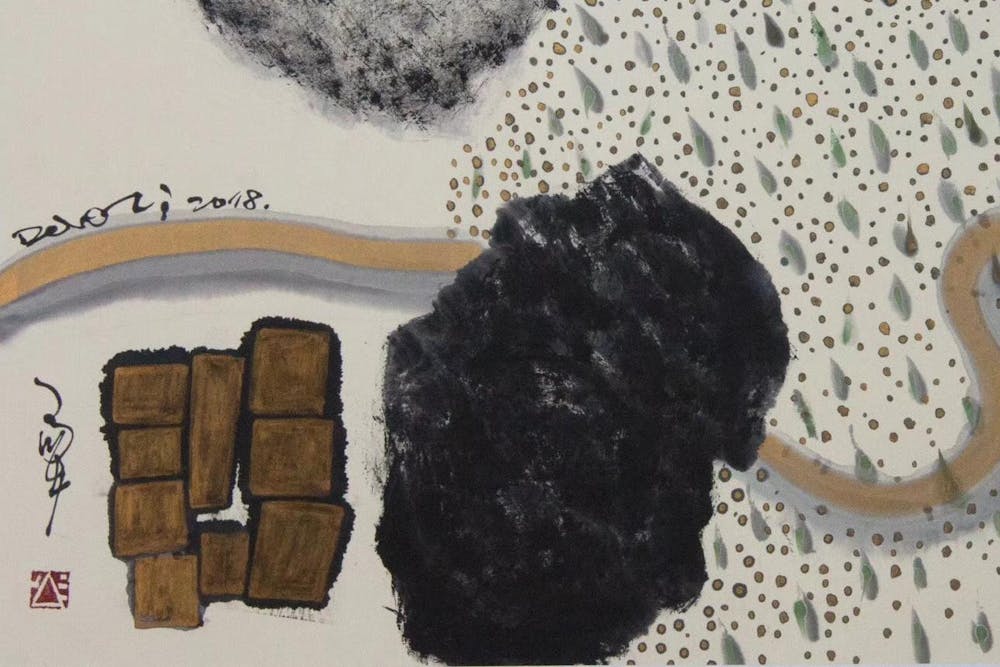“Transcendence + Immanence,” an exhibition by Chinese artist and critic DaoZi, is on display in the Duke Chapel from Oct. 20 - Nov. 26.
The installation consists of over a dozen ink wash paintings, created via an ancient Chinese brush-painting technique that utilizes black ink. Spanning the northern and southern interior walls of Duke Chapel, each monochrome piece is mounted by a stark white border and lightly-stained wood frame – easily absorbing into the cold, stone walls of the chapel.
The context of the chapel is as much a focus of the installation as the paintings themselves. Contrasting the brightly-colored stained-glass windows and the chapel’s vaulted ceiling are paintings actively restraining their use of both color and scale. The geometry of the surrounding gothic architecture is undercut by formless emissions of light.
As one’s eyes scan down the paintings, it’s easy to see shift from the formless divine to the rigid, well-shaped Earth. The immanence of “Immanence + Transcendence” is found in the complete denial of the maximalism of spaces like the chapel. While the chapel asks a visitor to look above and beyond to what lies beyond their grasp, DaoZi asks much less of his audience. He asks one to look at the undefined parts of themselves and grapple with why they are formless. He asks why one desires form and definition from the structures that surround them.
While the chapel uses every tool at its disposal to depict the grandiosity of faith, DaoZi’s works are defined by the simple contrast of light and dark. The specifically-chosen white bordering emphasizes the presence of darkness in his paintings – an interesting reversal of the expected importance placed on God’s grace through light. By drawing the viewer's eyes to the deep blackness of the ink, he is able to reflect the temperament of many in their everyday lives. Without DaoZi telling the viewer, they know that they find it much harder to see the light than the darkness. He isn’t tricking or training the eye, just extracting what it already wants to give.
Even though it is, at times, stylistically repetitious, the exhibit is able to both lull and explode with argument and fervor. After viewing several black, gray and white paintings in a row, the introduction of a basic maroon can carry an immense emotional impact. The change from a white to golden glow of a candle can demonstrate both the warmth of God’s grace and the shame that is felt in the presence of something you’re wholly unworthy of. By stripping his art of anything that could overpower his message, Daozi is able to distill his argument about where the divine is found. For him, the medium is the message.
The standout pieces in “Immanence + Transcendence” are found where the constants of DaoZi’s work are confronted – but not changed – by color and form. “Saving Grace” captures both form and light eloquently. On the bottom of the piece, Christ appears on the Cross, the first depiction of the divine with definition, with mourners surrounding him. The Christ figure is enveloped in white and a soft golden glow, yet one cannot help but be distracted by the white faces and black silhouettes of the mourners. In the several preceding paintings, man was only depicted in the starkest black. Now, with the word made flesh, the glow and immanence of God is felt and presented on the faces of those witnessing a crucifixion. While the passion of Christ is the theological centerpiece, the message is found in his reception.
“Transcendence + Immanence” is hosted through Duke Initiatives in the Theology and the Arts, an organization established in 2009 that explores the relationship between faith and art.
Get The Chronicle straight to your inbox
Signup for our weekly newsletter. Cancel at any time.

